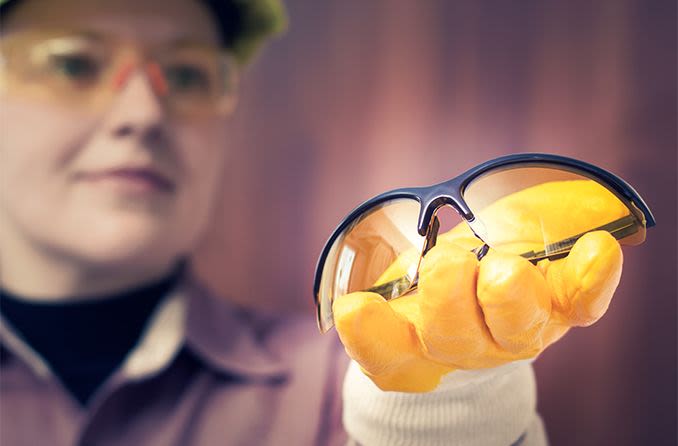When do you need prescription safety glasses?

While many of you wear prescription eyeglasses on a daily basis, the majority probably don’t think about wearing prescription safety glasses, but should you? It really depends on your work and/or recreation activities and environments.
Popular culture doesn’t portray safety glasses much. Aside from the odd aside in film — picture Jennifer Beals in heavy protective goggles while welding in “Flashdance” or the scientists researching a newly discovered contagion in “Outbreak,” and that about covers it.
But what if you’re making jewelry, doing house repairs or fiddling with tiny little objects that might leave you with something sharp careening toward your eyes? Safety glasses might be a smart investment.
And if you’re on a shooting range, you definitely need a pair of safety glasses.
We asked Chris Miranda, a safety consultant and president of MAC Safety for help deciding when prescription safety glasses might be a wise choice. Here’s what he said about when you need safety glasses and even how much they might cost:
Prescription safety glasses for work
“Safety glasses are needed in the industries or job settings that present eye hazards in the workplace,” Miranda said. Think woodworkers, welders, loggers, chainsaw operators and artists like those you see on that “Forged in Fire” TV series.
For safety glasses that will definitely shield your eyes, look for the ANSI Z87.1 stamp. This designation means they “are approved to be worn to protect from eye hazards,” which may include “flying debris or materials that may penetrate normal eyewear.”
Better yet? Seek out wrap-around safety glasses, similar to wraparound sunglasses, to “eliminate any hazards that may come from the side.”
On the TV series “Breaking Bad,” former chemistry teacher turned drug-creating criminal Walter White was sometimes pictured wearing safety goggles or even sunglasses that resembled wrap-around goggles. That’s not just TV, safety glasses often are a best practice in real life.
“Goggles are usually used for chemical safety — worn usually over safety glasses to provide extra protection,” Miranda says. That might include dust or even chemical splashes.
In specialty careers, safety glasses or goggles aren’t always used, but they probably should be. Miranda said that he once worked in a setting in which “police were dismantling a simulation of an explosive device.”
During the blast, debris penetrated an officer’s regular eyeglasses and caused a serious eye injury. Miranda adds the officer was incredibly fortunate not to have lost his eye.
What's the best tint for prescription safety goggles at work?
Tints for safety goggles are completely optional. “Tint/sunglasses are the discretion of not only the employee, but where you work.” Miranda says. For instance, “some employers don't want the sunglasses/tint.”
That could be because employers want both customers and co-workers to be able to look their employees in the eye. Also, inside a building or in too much shade could create a “dark view, which can lead to a tripping hazard,” Miranda notes.
On a construction site, Miranda says not everyone can wear tints or shades. “Machine operators are the ones usually on a construction site who are allowed (obviously) to wear sunglasses. If prescription safety goggles are needed, then they are acceptable.”
SEE RELATED: Do they make prescription safety sunglasses?
Safety goggles for sports and recreation
Shooting glasses, or some other kind of safety glasses, are a must on a firing range or if using artillery of some other sort.
Safety glasses can be handy at home, too. When mowing the lawn, safety glasses offer the best protection for your eyes, though Miranda notes, “a lot of people just wear normal sunglasses.”
Safety glasses and sunglasses both protect your eyes from grass shavings and allergens, but safety glasses are the better choice.
Skiers and bike riders are always on the lookout for the next hot pair of sports goggles to protect their eyes on the slopes and roads. If you worry that protective sports glasses are dorky, know that seven-time Tour de France green jersey winner and three-time road cycling world champ Peter Sagan wears them.
Hobbyists making jewelry, or children performing science experiments at home, should wear safety glasses, too. Safeguarding your eyes is important whether creating things or learning (especially when working with a chemistry set or model rockets, for example).
Speaking of safety glasses, you might want to put on a pair (and a helmet) the next time you ride a scooter, even on a quick trip to the office or coffee shop.
SEE RELATED: Prescription shooting glasses
When do you need a prescription safety glasses?
If you plan to wear your safety goggles and already need glasses to see, you’re probably best off ordering a pair of prescription goggles, which are designed so that you can see and still have safety protection.
Miranda adds that “side shields are required to be worn” even if it’s in the form of clip-ons “that prevent exposure from the side.”
Safety goggles, cost vs. style
Safety glasses have evolved over time in look, feel and price. “The comfort of goggles make them eyewear that you wear as needed, but not not all the time,” Miranda says.
Companies like Oakley have “made sports goggles more trendy,” Miranda says. And also, a little pricey.
But protecting your eyes doesn’t have to cost a lot. “You can buy safety glasses online in bulk for as little as $1.99 (you can imagine the look) vs. a pair of “cool” safety glasses for over $150 dollars,” Miranda says.
Bulk safety glasses and the “cool” safety glasses often offer the same level of protection, but just a different look, he adds.
RELATED READING: How the right safety glasses can help prevent workplace eye injuries
Page published on Saturday, March 28, 2020




